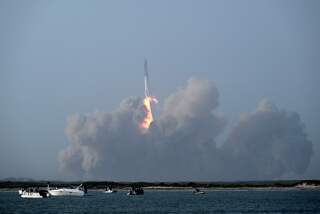Missile Intercepts Rocket in U.S. Test
WASHINGTON — The latest version of a national missile defense system gained a political boost Thursday when an interceptor missile destroyed a rocket in a test high above the New Mexico desert.
After six straight failures in recent years, a missile fired from White Sands Missile Range struck its target, a Scud-like missile. “People are extremely excited,” said Air Force Lt. Col. Rick Lehner at the Pentagon’s Ballistic Missile Defense Organization.
Indeed, from the Lockheed Martin plant in Sunnyvale, Calif.--where work on the project is taking place--to Congress, the successful test sparked high praise.
Congressional backers of the $3.8-billion Theater High Altitude Area Defense system--THAAD--seized on the test as proof that the expensive missile-interceptor system can protect U.S. troops from enemy missiles.
“For all of those people who stood on the House floor and said missile defense doesn’t work, guess what? Today we hit a bullet with a bullet,” Rep. Curt Weldon (R-Pa.), chairman of the House Armed Services Committee’s research and development subcommittee, said during House debate on a defense bill.
The Clinton administration responded more cautiously. “This is clearly a step in the right direction,” said P.J. Crowley, a spokesman for the National Security Council.
But he added: “It’s [President Clinton’s] view that we need to be sure the technology will work before making a deployment decision on a national missile defense system.”
Republicans have been pushing the administration to deploy such a system. But until recently, the administration had been less enthusiastic, saying it wanted to make sure the system worked before committing more funds to it. Thursday’s successful test will boost GOP arguments that the administration should accelerate building and deploying the system.
Skeptics of the viability of the defense system were unswayed by Thursday’s test. John Isaacs, president of the Council for a Livable World, a Washington-based group that favors arms control, said: “One out of seven, even in baseball, is not a very good average. . . . That’s a long way from showing that we can build and deploy a system that will be reliable and consistently effective.”
Weldon, however, argued that test failures are an inevitable part of evaluating new technology.
Three more tests are planned. The next is set for mid-July. Under the government’s contract with Lockheed Martin, there must be three successful intercepts for the project to proceed to the next phase.
A contract provision caused Lockheed to be fined $15 million after an interceptor missile flew past its target in March.
Another test was postponed in May because of problems with the target rocket. If the system cannot make a second successful intercept by July 16, Lockheed will owe the government an extra $20 million in penalties.
Unlike President Ronald Reagan’s Strategic Defense Initiative, dubbed “Star Wars,” which envisioned a system of orbiting lasers that would zap enemy missiles from outer space, the THAAD system uses ground-based missiles.
More to Read
Sign up for Essential California
The most important California stories and recommendations in your inbox every morning.
You may occasionally receive promotional content from the Los Angeles Times.











